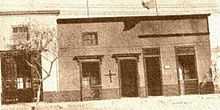Chilenization of Tacna, Arica and Tarapacá

Chilenization of Tacna, Arica and Tarapacá describes a process of forced transculturation or acculturation in the zones (Tacna, Arica and Tarapacá) which were invaded and incorporated by Chile since the War of the Pacific (1879–1883). The aim of the Chilenization was to create a dominance of Chilean traditions and culture in that region, in preference to those of the overwhelming Peruvian population. British interests to reunite all saltpeter mines under one political administration was also a major factor that influenced in the outcome of the war.[1]
After the failure of Chile to ratify the Billinghurst-Latorre protocol, Chile began in the provinces of Tacna and Arica a policy which has been called "Chilenization". This has consisted in the closing of school conducted by Peruvians, the extension of the military zone to Tacna, the dismissal of Peruvian prelates and interference with Peruvian religious establishments, the initiation of a Chilean press propaganda and restrictions upon Peruvian press and political agitation, and a colonization policy for Chileans.[2]
Background
Starting from the Chilean silver rush in the 1830s, Atacama (a Bolivian region) was prospected and populated by Chileans backed by Chilean and European (mainly British) capital.[3] Chilean and foreign enterprises in the region eventually extended their control to the Bolivian saltpeter mines. During the 1870s, Peru capitalized on the guano exploitation and nationalized all industries in Tarapacá, but Bolivian enterprises in its territory remained in private hands. Peru controlled 58.8% of all saltpeter production, while Chile held 19% and Great Britain 13.5%.[4]
According to the 1976 census Peruvians represented the majority of the population in Tarapacá, followed by Chileans and Bolivians.[5] Conflicts between Chilean and Bolivian miners were common in Peruvian saltpeterworks.[6] However, there were no dispute about the Peruvian sovereignty of this territory. In fact, before the war, Peru's southern border was with Bolivia and not Chile.[7]
See also
References
- ↑ http://www.revistacienciasociales.cl/archivos/revista5/pdf/rcs5_3.pdf
- ↑ http://www.jstor.org/stable/20028196?seq=18#page_scan_tab_contents
- ↑ Bethell, Leslie. 1993. Chile Since Independence. Cambridge University Press. pp. 13-14.
- ↑ British Influence on the Salt: The Origin, Nature and Decline, Soto Cárdenas, Alejandro. Santiago : Ed. University of Santiago de Chile, 1998. Page 50
- ↑ http://codex.colmex.mx:8991/exlibris/aleph/a18_1/apache_media/JTHL1E8LTYHXU8L2RSVCIMDGLC8DHE.pdf
- ↑ Vergara, Jorge Iván; Gundermann, Hans (2012). "Constitution and internal dynamics of the regional identitary in Tarapacá and Los Lagos, Chile". Chungara (in Spanish) (University of Tarapacá) 44 (1): 115–134. doi:10.4067/s0717-73562012000100009.
- ↑ http://www.jstor.org/stable/20028196?seq=5#page_scan_tab_contents
| ||||||||||||||